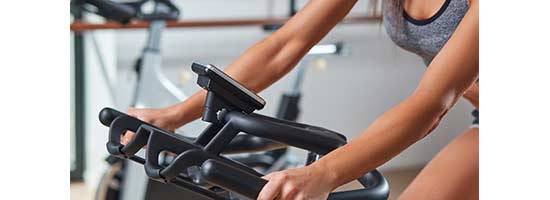
How Indoor Cycling Could Help Ease Chronic Pain
Some types of chronic pain stem from issues with weakened muscles around bones of the spine and joints. While many people turn to pain or anti-inflammatory medications to control this type of pain, exercise can be even more effective. Not all forms of exercise are appropriate for people with chronic pain. However, there is some encouraging research suggesting that indoor cycling may be a safe and effective way to curb chronic pain and improve your daily quality of life.
The Body’s Natural Painkillers Kick In
One study found that exercising for 40 minutes three times each week reduced attacks for chronic migraine sufferers better than anticonvulsant drugs. Similar research suggests cycling on a recumbent stationary bike can also ease spine-related stress and discomfort. Part of the reason for this may be because exercise increases the production of endorphins, chemicals naturally produced by the nervous system that have pain-relieving effects similar to low doses of certain pain medications.
Spine-Supporting Muscles Get Stronger
An Australian study found that people with non-specific low back pain (LBP) reported significant decreases in their pain after eight weeks of stationary bike workouts. The results could be, in part, due to the way indoor cycling targets many of the core muscles that support the lower back area. When supporting muscles get stronger, less stress is placed on the spine from daily movements, which could mean fewer issues with chronic pain.
Oxygenation Increases and Helps Muscles Relax
A Danish study found that individuals with neck and shoulder muscle pain linked to work-related injuries experienced greater oxygenation in muscles within this area after moderate intensity cycling for 20 minutes. These results are more likely to be experienced when indoor cycling in an upright position with your shoulder relaxed, which is the stationary bike posture you should be maintaining anyway.
Movement and Flexibility Improve
There’s also research suggesting indoor cycling is a form of exercise that may help people with chronic pain affecting movement, flexibility, and range of motion. In fact, a Northern Illinois University study found that people with knee pain related to osteoarthritis (OA) significantly improved their walking pace after three months of stationary cycling workouts.
If your doctor gives you the okay to go ahead with indoor cycling on a regular basis, be sure to adjust your bike before using it, especially if you’ll be going to a gym or fitness center. Sit on the stationary or exercise bike to make sure the handlebars don’t force you to lean excessively forward. With the pedal height, your knee should be slightly bent when the pedal is in the lowest position. If you’re new to indoor cycling, start slowly and work up your endurance at a pace that’s comfortable for you.



